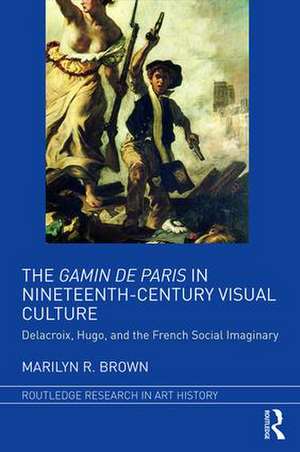The Gamin de Paris in Nineteenth-Century Visual Culture: Delacroix, Hugo, and the French Social Imaginary: Routledge Research in Art History
Autor Marilyn R. Brownen Limba Engleză Hardback – 12 mai 2017
Din seria Routledge Research in Art History
-
 Preț: 314.01 lei
Preț: 314.01 lei - 9%
 Preț: 1038.36 lei
Preț: 1038.36 lei - 9%
 Preț: 935.79 lei
Preț: 935.79 lei -
 Preț: 309.79 lei
Preț: 309.79 lei -
 Preț: 334.94 lei
Preț: 334.94 lei -
 Preț: 312.34 lei
Preț: 312.34 lei - 9%
 Preț: 937.61 lei
Preț: 937.61 lei -
 Preț: 317.19 lei
Preț: 317.19 lei - 9%
 Preț: 1039.51 lei
Preț: 1039.51 lei -
 Preț: 311.22 lei
Preț: 311.22 lei - 9%
 Preț: 935.68 lei
Preț: 935.68 lei -
 Preț: 310.99 lei
Preț: 310.99 lei - 9%
 Preț: 937.21 lei
Preț: 937.21 lei - 9%
 Preț: 940.58 lei
Preț: 940.58 lei -
 Preț: 371.71 lei
Preț: 371.71 lei - 26%
 Preț: 766.24 lei
Preț: 766.24 lei - 25%
 Preț: 774.56 lei
Preț: 774.56 lei - 17%
 Preț: 258.91 lei
Preț: 258.91 lei - 25%
 Preț: 824.40 lei
Preț: 824.40 lei - 25%
 Preț: 778.00 lei
Preț: 778.00 lei - 26%
 Preț: 764.20 lei
Preț: 764.20 lei - 26%
 Preț: 764.20 lei
Preț: 764.20 lei - 17%
 Preț: 258.70 lei
Preț: 258.70 lei - 26%
 Preț: 765.95 lei
Preț: 765.95 lei - 16%
 Preț: 260.93 lei
Preț: 260.93 lei - 15%
 Preț: 268.62 lei
Preț: 268.62 lei - 25%
 Preț: 768.30 lei
Preț: 768.30 lei - 25%
 Preț: 766.85 lei
Preț: 766.85 lei - 17%
 Preț: 259.98 lei
Preț: 259.98 lei - 26%
 Preț: 766.12 lei
Preț: 766.12 lei - 26%
 Preț: 764.20 lei
Preț: 764.20 lei - 25%
 Preț: 769.10 lei
Preț: 769.10 lei - 25%
 Preț: 770.48 lei
Preț: 770.48 lei - 26%
 Preț: 764.20 lei
Preț: 764.20 lei - 25%
 Preț: 853.93 lei
Preț: 853.93 lei - 25%
 Preț: 767.20 lei
Preț: 767.20 lei - 25%
 Preț: 767.38 lei
Preț: 767.38 lei - 25%
 Preț: 770.45 lei
Preț: 770.45 lei - 25%
 Preț: 771.88 lei
Preț: 771.88 lei - 25%
 Preț: 771.47 lei
Preț: 771.47 lei - 25%
 Preț: 767.47 lei
Preț: 767.47 lei
Preț: 765.23 lei
Preț vechi: 1028.01 lei
-26% Nou
Puncte Express: 1148
Preț estimativ în valută:
146.43€ • 151.30$ • 121.81£
146.43€ • 151.30$ • 121.81£
Carte tipărită la comandă
Livrare economică 19 martie-02 aprilie
Preluare comenzi: 021 569.72.76
Specificații
ISBN-13: 9781138231139
ISBN-10: 1138231134
Pagini: 190
Ilustrații: 24 Halftones, color; 37 Halftones, black and white; 24 Illustrations, color; 37 Illustrations, black and white
Dimensiuni: 174 x 246 x 15 mm
Greutate: 0.51 kg
Ediția:1
Editura: Taylor & Francis
Colecția Routledge
Seria Routledge Research in Art History
Locul publicării:Oxford, United Kingdom
ISBN-10: 1138231134
Pagini: 190
Ilustrații: 24 Halftones, color; 37 Halftones, black and white; 24 Illustrations, color; 37 Illustrations, black and white
Dimensiuni: 174 x 246 x 15 mm
Greutate: 0.51 kg
Ediția:1
Editura: Taylor & Francis
Colecția Routledge
Seria Routledge Research in Art History
Locul publicării:Oxford, United Kingdom
Public țintă
Postgraduate and UndergraduateCuprins
Table of Contents
List of Illustrations
Acknowledgments
Introduction
Ch. 1 Revolutionary Ancestors of the Gamin de Paris
Ch. 2 Child of the People and Child of the Fatherland in Nineteenth-Century French Social History
Ch. 3 Child of the People and Child of the Fatherland in the French Social Imaginary
Ch. 4 The Gamin de Paris and the Revolution of 1830
Ch. 5 The Gamin de Paris in Panoramic Literature and in the Revolutions of 1848
Ch. 6 The Gamin de Paris, the Second Empire, and the Commune
Ch. 7 The Gamin de Paris during the Early Third Republic
Epilogue
Bibliography
List of Illustrations
Acknowledgments
Introduction
Ch. 1 Revolutionary Ancestors of the Gamin de Paris
Ch. 2 Child of the People and Child of the Fatherland in Nineteenth-Century French Social History
Ch. 3 Child of the People and Child of the Fatherland in the French Social Imaginary
Ch. 4 The Gamin de Paris and the Revolution of 1830
Ch. 5 The Gamin de Paris in Panoramic Literature and in the Revolutions of 1848
Ch. 6 The Gamin de Paris, the Second Empire, and the Commune
Ch. 7 The Gamin de Paris during the Early Third Republic
Epilogue
Bibliography
Notă biografică
Marilyn R. Brown is author of Degas and the Business of Art: A Cotton Office in New Orleans (CAA Monograph, 1994) and editor of, and contributor to, Picturing Children: Constructions of Childhood Between Rousseau and Freud (Ashgate, 2002; Routledge 2017). She is professor of art history at the University of Colorado.
Recenzii
"Brown’s meticulously researched illuminating study of the trajectory of the gamin across the nineteenth century makes a compelling case for the centrality of the gamin topos in French visual culture ... In her perceptive critical reading of individual images Brown offers a compelling demonstration of the challenges and rewards of examining visual culture in relation to political events and the vicissitudes of history."
--Nineteenth-Century Art Worldwide
--Nineteenth-Century Art Worldwide
Descriere
The book argues that images of the Paris urchin addressed transformations at the heart of modernity, including the decline of patriarchal, monarchical social structures and the rise of industrial capitalism and colonialism. It parses a contested national archetype that emerged from repeated, recycled representations of revolutions (1830, 1832, 1848, 1871).















